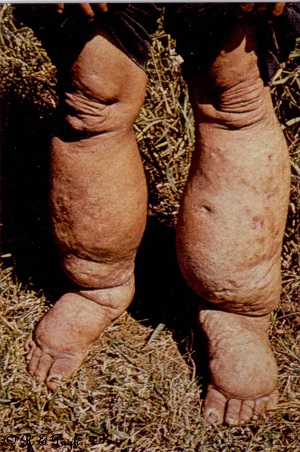Brugia malayi - Clinical Manifestation
Clinical Manifestation of Brugia malayi
The clinical manifestation of Brugia malayi includes Malayan lymphatic filariasis with the pre-patent period being short (i.e. 3.5 months on average). The incubation period is also short and may vary from 8 months to 16 months.
In humans, Brugia malayi may manifest as:
Endemic normal
Asymptomatic stage
Acute stage
Chronic stage
Endemic normal
In areas endemic to filariasis caused by Brugia malayi, a portion of the population does not show any overt clinical manifestation of the disease. Such a population may also lack microfilariae in the blood even if they are exposed to the infective third-stage larvae (L3).
However, it is difficult to demonstrate if the said population is uninfected by Brugia malayi or simply has undetected filarial nematode infection.
Asymptomatic stage
Individuals in the asymptomatic stage of Brugia malayi infection have microfilariae in their blood but lack any clinical manifestations of filariasis. Such individuals may remain asymptomatic for years and even for a lifetime. If such individuals settle in non-endemic filarial areas, they may spontaneously become microfilaraemia.
The asymptomatic stage in individuals has been suggested to have been caused by the downregulation of the TH1 inflammatory component of the immune response while the TH2 is stimulatory. It also involves depressed cytokine IFN-c but elevated IL-4 levels (IL4 suppresses activation of TH1).
After several years, hyporesponsiveness breaks down and the appearance of inflammatory reactions begins.
Acute filariasis
The inflammatory phase i.e. acute filariasis is caused by antigens released from the female Brugia malayi parasite while microfilariae are not responsible for inflammatory changes.
This condition manifests as:
Filarial fever
Lymphadenitis
Adenolymphangitis (ADL)
Lymphoedema
Filarial fever
filarial fever due to Brugia malayi infection is usually low grade
sometimes filarial fever may be accompanied by chills and become severe
symptoms include general malaise, pain, headache
episodes of filarial fever may occur several times a year – which lasts upto a week each time
Lymphoedema
lymphoedema is caused by the presence of adult worms in the lymphatic channels
lymph flow is hindered by the Brugia malayi parasite
individuals with lymphoedema suffer from periodic attacks of filarial fever, adenolymphangitis, and lymphadenitis
Lymphadenitis
in lymphadenitis, the lymph nodes are inflamed
commonly infected lymph nodes include epitrochlear, cervical, axillary, inguinal, abdominal, pelvic, supraclavicular
unusual lymph nodes infected include wrist, iliac, pectoral, creat, mediastinal, intercostal, mid humoral
infected lymph nodes are tender, enlarged, and matted but are not attached to the skin
such lymph nodes may or may not contain Brugia malayi parasites
lymph nodes capsules are thickened with fibrotic septa while the middle layer of the node may contain dead or living male and female adult Brugia malayi filarial nematode
scar tissue is present in the outer layers
Adenolymphangitis (ADL)
adenolymphangitis (ADL) is the inflammation of lymph channels
commonly occurs during the attacks of the acute stage
lymphatic vessels are thickened, dilated, and folded
thickened walls of lymphatic vessels contain a large number of inflammatory cells surrounded by tissue
inflammation of inguinal lymph nodes, lymphoedema, testis, spermatic cord
symptoms include fever episodes with tender, thickened, firm, red lymphatics, and tender skin
usually, male genitals are affected which results in orchitis, epididymitis, or funiculitis
in some cases, the lymphatic system of the upper extremities and breasts are infected
ADL completely subsides after the acute stage but after each attack, edema becomes less resolved, resulting in the development of characteristic chronic filariasis
Chronic filariasis (Obstructive phase)
Chronic filariasis, also known as the obstructive phase, takes 10 to 15 years to develop after an individual is infected with Brugia malayi. During this stage, acute inflammation subsides while fibrosis advances as the parasitic worms die, are absorbed, or are calcified.
Microfilariae are usually absent in chronic cases.
Clinical manifestations of chronic filariasis caused by Brugia malayi include:
Lymph varices
Hydrocele
Elephantiasis
Lymph varices
involves varicose lymph ducts
caused by obstruction of lymph nodes and accumulation of lymph in the ducts
resulted condition is dilation of the ducts
Hydrocele
hydrocele is the most common clinical manifestation in chronic Brugia malayi infection
caused by obstruction of lymph vessels of the spermatic cord and exudation from the inflamed testes and epididymis
hydrocele fluid is amber in color and contains fibrin, cholesterol crystals, calcium particles, old blood clots, and mesothelial cells
microfilariae of Brugia malayi can be found in the hydrocele fluid while adult worms are present in the cord and epididymal tissues

elephantiasis caused by Brugia malayi (Source: parasite.org.au)
Elephantiasis
elephantiasis is a characteristic feature of chronic Brugia malayi infection
caused by complex immune reactions for a long duration as well as repeated infections over many years
this manifestation is seen only in a small percentage of infected individuals in endemic areas
in males, elephantiasis occurs in the scrotum, legs, and arms
in females, elephantiasis is seen in arms and legs
if legs and arms are infected, swelling is seen below the knee and below the elbow respectively
at first, swelling is pitting which later becomes non-pitting
the elephantoid mass consists of fibrous tissues containing fat
overlaying skin of the leg, the scrotum becomes thick, warty, and fissured
ulceration and secondary infection with fungi or bacteria also may occur
peripheral blood usually lacks Brugia malayi microfilariae